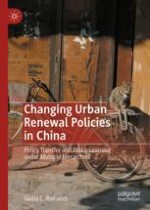2020 | OriginalPaper | Buchkapitel
3. The Chinese Paradigm of Urban Renewal in the Early 2000s
verfasst von : Giulia C. Romano
Erschienen in: Changing Urban Renewal Policies in China
Aktivieren Sie unsere intelligente Suche, um passende Fachinhalte oder Patente zu finden.
Wählen Sie Textabschnitte aus um mit Künstlicher Intelligenz passenden Patente zu finden. powered by
Markieren Sie Textabschnitte, um KI-gestützt weitere passende Inhalte zu finden. powered by
